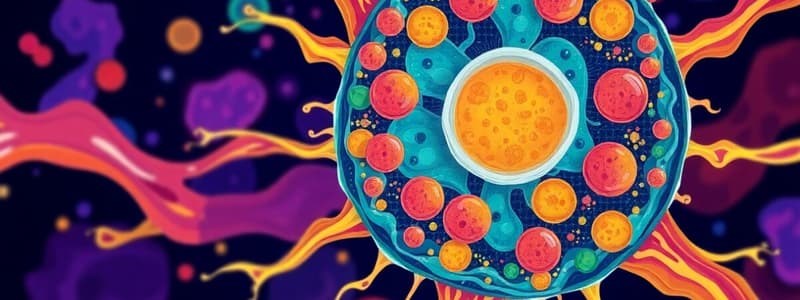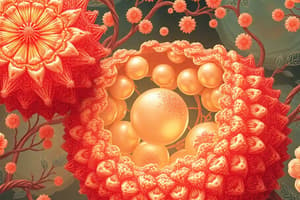Podcast
Questions and Answers
A cell with a high rate of protein secretion would likely have an abundance of which of the following structures?
A cell with a high rate of protein secretion would likely have an abundance of which of the following structures?
- Rough endoplasmic reticulum (correct)
- Smooth endoplasmic reticulum
- Lysosomes
- Mitochondria
Which of the following is a major difference between prokaryotic and eukaryotic cells?
Which of the following is a major difference between prokaryotic and eukaryotic cells?
- Eukaryotic cells have a membrane-bound nucleus; prokaryotic cells do not. (correct)
- Prokaryotic cells lack a plasma membrane.
- Eukaryotic cells lack ribosomes.
- Prokaryotic cells contain membrane-bound organelles.
Why is a high surface area-to-volume ratio important in cells?
Why is a high surface area-to-volume ratio important in cells?
- It minimizes the amount of DNA needed in the cell.
- It reduces the number of organelles required for cellular function.
- It decreases the rate of heat production.
- It facilitates the exchange of materials between the cell and its environment. (correct)
The nuclear envelope is continuous with what other organelle in the eukaryotic cell?
The nuclear envelope is continuous with what other organelle in the eukaryotic cell?
Where are ribosomes found within eukaryotic cells?
Where are ribosomes found within eukaryotic cells?
Flashcards
Cell
Cell
Basic unit of life, sharing key features like a plasma membrane, cytosol, chromosomes, and ribosomes.
Prokaryotic Cell
Prokaryotic Cell
Lacks a nucleus and other membrane-bound organelles; DNA resides in a nucleoid region.
Eukaryotic Cell
Eukaryotic Cell
Has a nucleus (containing DNA) and other membrane-bound organelles.
Plasma Membrane
Plasma Membrane
Signup and view all the flashcards
Cytoplasm
Cytoplasm
Signup and view all the flashcards
Study Notes
- The cell is the fundamental unit of life.
Cell Features
- All cells share common features like a plasma membrane, cytosol, chromosomes, and ribosomes.
- Cytosol is a semifluid interior.
- Chromosomes contain genes.
- Ribosomes are responsible for protein synthesis.
Cell Types
- There are two main types of cells: prokaryotic and eukaryotic.
- Prokaryotic cells lack a nucleus, and their DNA is located in the nucleoid.
- Prokaryotes do not have membrane-bound organelles.
- Eukaryotic cells have DNA enclosed within a nucleus, surrounded by a membranous envelope.
- Eukaryotes possess membrane-bound organelles.
- The cytoplasm of eukaryotic cells is located between the plasma membrane and the nucleus.
Cell Size
- Cells are small to maintain a high surface area-to-volume ratio.
- A larger surface area-to-volume ratio facilitates the absorption of nutrients and other essential substances.
- A small surface are-to-volume ratio is bad for cells.
Cell Compartmentalization
- Cell compartmentalization refers to the presence of specific functions within distinct compartments inside the cells.
Cell Membranes
- The plasma membrane acts as a selective barrier, regulating the movement of substances in and out of the cell.
- It consists of a phospholipid bilayer, proteins, and cholesterol.
Cytoplasm
- The cytoplasm is the region between the plasma membrane and the nucleus.
- It consists of cytosol, a fluid containing organelles, and is constantly flowing.
Nucleus
- The nucleus houses the cell's DNA, organized into chromosomes.
- It is enclosed by a nuclear envelope, a double membrane that separates it from the cytoplasm.
- Nuclear pores regulate the passage of molecules between the nucleus and cytoplasm.
- The nucleolus, located within the nucleus, is where ribosomal RNA (rRNA) is synthesized, and ribosome subunits are made.
Ribosomes
- Ribosomes, composed of rRNA and proteins, are responsible for protein synthesis.
- Ribosomes are found in two locations: in the cytosol (free ribosomes) where they produce proteins for the cytoplasm, and on the outside of the rough ER, where they typically synthesize proteins for export or insertion into membranes.
Studying That Suits You
Use AI to generate personalized quizzes and flashcards to suit your learning preferences.




